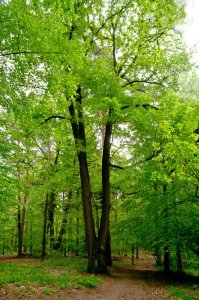
Winter Oak (Quercus petraea)

| Occurrence in Děčín |
Large winter oaks can be found in the upper part of the Bažantnice forest park, where the trunk strength reaches up to 1m, the largest of which is 1.20m. The tree you stand by is probably the largest representative of the winter oak on the Shepherd's Wall. It has a circumference of 330cm and a height of 25m. |
| Application |
In
landscaping it is very valuable and widespread, especially in landscape and
large urban parks it forms the basis of tree stands. It is planted in groups
such as solitaire and alley, as well as for reinforcement of pond dams. It
willingly crosses with the summer oak, so especially in the lower altitudes,
the forest oak stands are just these hybrids. |
| Habitat |
Grows on rocky, drier soils, forms mixed oak forests from lowlands to submontane zone at altitudes 600-750 m above sea level. It tolerates the urban environment well. It is resistant to frost and exhalates. |
| Location |
Europe
except East to Northeast, Asia Minor. |
| Wood |
Use
similar to summer oak. |
| Fruits |
2-3 cm
long, ovate-oblong acorns, seated in 1/4 in densely scaled goblet, almost
sessile. |
| Blossom |
Blooms
in May when the leaves sprout, inconspicuously. |
| Leaves | Oblong-oval, 8-15cm long, short lobed, 5-7 narrow on each side, converging lobes to tip, base cuneate to rounded. Dark green, glabrous and shiny at the top, gray-green beneath, thickly hairy on veins, red-tufts of hair in the axils of veins with small bunches. Petioles 1-2cm long, yellow, as well as the main vein. Autumn color is yellow-brown. Part of the dry leaves remains on the branches over the winter, hence its name. |
| Branches |
Young
annuals glabrous. |
| Rind |
Bark
is thick, initially shiny dark green, later dark black-gray, long cracked,
ribbed. |
| Treetop |
30-40
m tall tree with ovoid to broad crown and long trunk. It can grow to 4m in
diameter (England, Germany). |
| Note |
Our biggest winter oak was the so-called
"Albrechtický dědoušek", which grew in the cadastre of Albrechtice in
the vicinity of the chateau park under the Jezeří chateau in the Most region.
It was the so-called "border tree", which until then only survived
five. At the end of the 19th century. (published in J.E.Chadt-Sevetinsky's
publication: "Old and memorable trees in Bohemia, Moravia and Silesia")
had 1230 cm in perimeter, and 1000 years old. At that time it was the largest
oak not only in our country but also in Central Europe. At the turn of the 19th
and 20th centuries, a massive branch broke off with a piece of tree, so a large
cavity appeared. It was roofed, and in this form I knew it when I went to
school around it in the 1950s. Despite all the adversity, he was still in good
health at the beginning of the 1990s, and in 1993, when I visited him, he grew
with new shoots. But in the summer of the same year he was repeatedly burned by
an "unknown" vandal. Remarkable was the immediate announcement of the
mining company of "lighting the oak with lightning" (no storm was
observed long before or after the oak firing). People from the wider surroundings
of the flower wore the burned oak, a thorn in the eye of the company. By doing
so, the tree's torso was disproved by the bulldozer and then completely removed
to leave nothing left of it ... |





